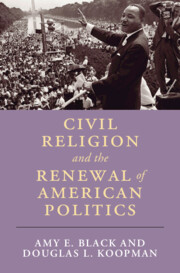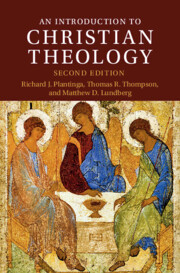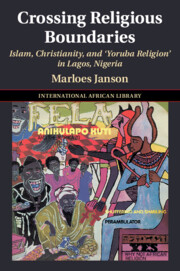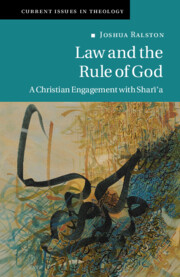Refine search
Actions for selected content:
25 results
10 - Alternative Visions of National Identity
- from Part III - Contemporary Divisions
-
- Book:
- Civil Religion and the Renewal of American Politics
- Published online:
- 09 October 2025
- Print publication:
- 23 October 2025, pp 204-222
-
- Chapter
- Export citation
1 - Introduction
-
- Book:
- Civil Religion and the Renewal of American Politics
- Published online:
- 09 October 2025
- Print publication:
- 23 October 2025, pp 1-8
-
- Chapter
- Export citation

Civil Religion and the Renewal of American Politics
-
- Published online:
- 09 October 2025
- Print publication:
- 23 October 2025
4 - Reformation and Confessional Pluralism
- from Part II - Notions and Practices of Equality
-
- Book:
- Democracy's Double Helix
- Published online:
- 09 September 2025
- Print publication:
- 14 August 2025, pp 129-140
-
- Chapter
- Export citation
Engaging philosophically with Afro-Brazilian religions
-
- Journal:
- Religious Studies / Volume 61 / Issue 2 / June 2025
- Published online by Cambridge University Press:
- 25 April 2025, pp. 448-452
- Print publication:
- June 2025
-
- Article
-
- You have access
- HTML
- Export citation
In a Time of Crisis: Reflections on the Fortieth Anniversary of the Journal of Law and Religion
-
- Journal:
- Journal of Law and Religion / Volume 40 / Issue 1 / January 2025
- Published online by Cambridge University Press:
- 23 April 2025, pp. 20-27
-
- Article
-
- You have access
- Open access
- HTML
- Export citation
Clinical Ethics and the Observant Jewish and Muslim Patient: Shared Theocentric Perspectives in Practice
-
- Journal:
- Cambridge Quarterly of Healthcare Ethics / Volume 34 / Issue 2 / April 2025
- Published online by Cambridge University Press:
- 22 November 2024, pp. 247-263
-
- Article
-
- You have access
- Open access
- HTML
- Export citation
Religious pluralism of Muslim practices in China: the cases of ritual participation from Hui and Uyghur societies
-
- Journal:
- International Journal of Asian Studies , First View
- Published online by Cambridge University Press:
- 06 November 2024, pp. 1-15
-
- Article
-
- You have access
- Open access
- HTML
- Export citation
2 - Apophaticism and Perennialism
-
- Book:
- Exploring Religious Pluralism
- Published online:
- 14 March 2024
- Print publication:
- 21 March 2024, pp 16-35
-
- Chapter
- Export citation
1 - Pluralist Persia
- from Part I - Uncertain Overtures (1796–1914)
-
- Book:
- Heroes to Hostages
- Published online:
- 03 August 2023
- Print publication:
- 24 August 2023, pp 17-36
-
- Chapter
- Export citation
Mendelssohn and the Protestant Pedants: The Skeptical Rabbis, the Principle of Noncontradiction, and Judaism’s Spiritual Dialogue
-
- Journal:
- Harvard Theological Review / Volume 116 / Issue 4 / October 2023
- Published online by Cambridge University Press:
- 14 August 2023, pp. 599-625
- Print publication:
- October 2023
-
- Article
-
- You have access
- Open access
- HTML
- Export citation
16 - Religious Pluralism and Social Unions
- from Part IV - Pluralism, Democracy, and the Future of Justice as Fairness
-
-
- Book:
- Rawls’s <i>A Theory of Justice</i> at 50
- Published online:
- 20 July 2023
- Print publication:
- 10 August 2023, pp 277-295
-
- Chapter
- Export citation
‘Elections can wait!’ The politics of constructing a ‘Hindu atmosphere’ in Kerala, South India
-
- Journal:
- Modern Asian Studies / Volume 57 / Issue 6 / November 2023
- Published online by Cambridge University Press:
- 19 July 2023, pp. 2067-2099
- Print publication:
- November 2023
-
- Article
-
- You have access
- Open access
- HTML
- Export citation

An Introduction to Christian Theology
-
- Published online:
- 18 October 2022
- Print publication:
- 03 November 2022
-
- Textbook
- Export citation
1 - Antisemitism in the Pagan World
- from Part I - The Classical Period
-
-
- Book:
- The Cambridge Companion to Antisemitism
- Published online:
- 05 May 2022
- Print publication:
- 02 June 2022, pp 25-41
-
- Chapter
- Export citation
Sulh-i kull as an oath of peace: Mughal political theology in history, theory, and comparison
-
- Journal:
- Modern Asian Studies / Volume 56 / Issue 3 / May 2022
- Published online by Cambridge University Press:
- 08 April 2022, pp. 721-748
- Print publication:
- May 2022
-
- Article
- Export citation
Chinggisid pluralism and religious competition: Buddhists, Muslims, and the question of violence and sovereignty in Ilkhanid Iran
-
- Journal:
- Modern Asian Studies / Volume 56 / Issue 3 / May 2022
- Published online by Cambridge University Press:
- 08 April 2022, pp. 815-839
- Print publication:
- May 2022
-
- Article
-
- You have access
- Open access
- HTML
- Export citation

Crossing Religious Boundaries
- Islam, Christianity, and ‘Yoruba Religion' in Lagos, Nigeria
-
- Published online:
- 16 September 2021
- Print publication:
- 10 June 2021

Law and the Rule of God
- A Christian Engagement with Shari'a
-
- Published online:
- 28 October 2020
- Print publication:
- 05 November 2020
9 - Social Religious Epistemology
-
- Book:
- The Transmission of Knowledge
- Published online:
- 21 August 2020
- Print publication:
- 27 August 2020, pp 161-184
-
- Chapter
- Export citation
